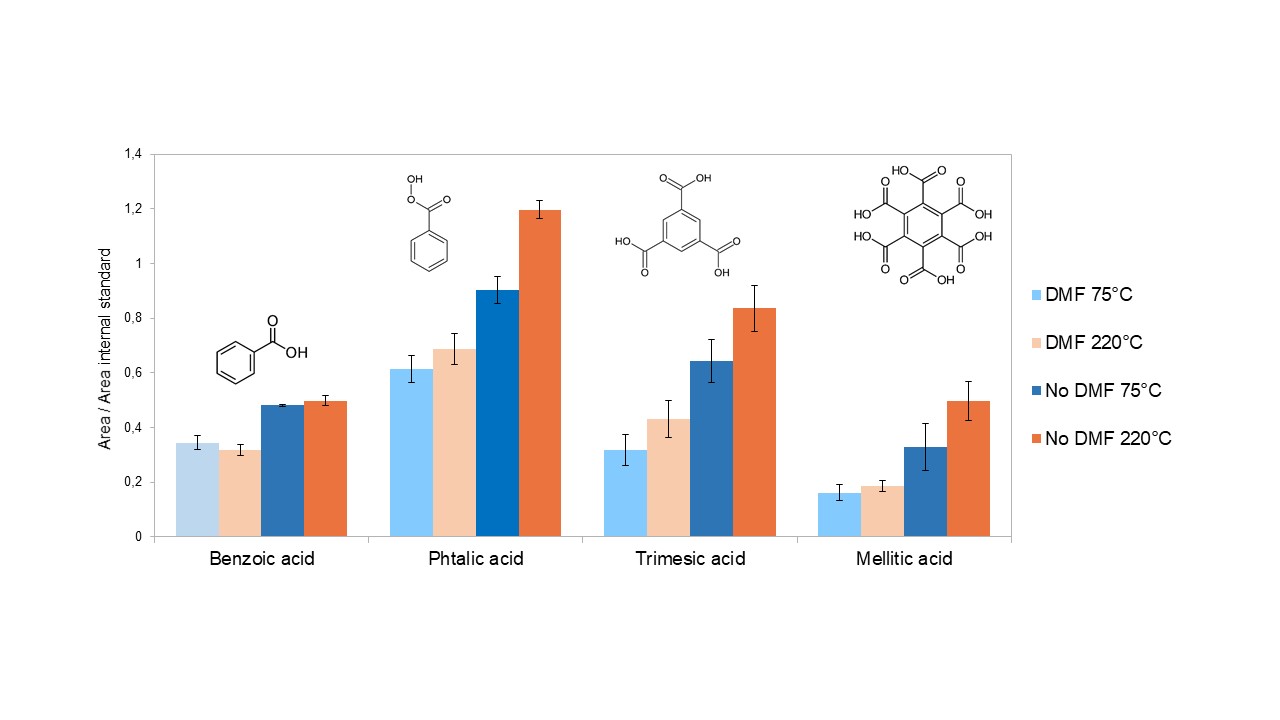Extraction and derivatisation of organic molecules on Mars: optimising sample preparation under MOMA instrument conditions
- 1Univ Paris Est Creteil and Université Paris Cité, CNRS, LISA, F-94010 Créteil, France (rgonthier@lisa.ipsl.fr)
- 2Université Paris Cité and Univ Paris Est Creteil, CNRS, LISA, F-75013 Paris, France
- 3Univ. Lille, CNRS, Univ. Littoral Côte d'Opale, UMR 8187 - LOG, F-59000 Lille, France
- 4Institut Universitaire de France (IUF)
The Mars Organic Molecule Analyzer instrument (MOMA) in the Exomars Rosalind Franklin rover can analyse Mars samples with different technics: Laser Desorption-Mass Spectrometry, Pyrolysis-Gas Chromatography-Mass Spectrometry (Pyr-GC-MS), and derivatisation followed by GC-MS. For the last one, three different derivatisation reagents are available and can be used depending on the molecular families to be functionalised: TMAH, DMF-DMA and MTBSTFA. They are sealed in metallic capsules opening at a specific temperature using relevant eutetics. Hence, the sample can be heated in the oven before reacting with the reagent. This can enable to dry the sample, removing most of the free water present in the sample that could consume a part of the reagent, and to proceed to a thermal extraction of the organic molecules, enhancing their recovery yield. However, compared with classical routine laboratory procedures, this in-situ wet chemistry sample preparation implies very specific conditions due to this one pot one step system and space instrumental constraints in term of weight, operational temperature and available energy.
We focused our work on GC-MS with sample derivatisation by MTBSTFA. This reagent is kept in tight capsules that open only at 221°C whereas routine similar laboratory derivatisation reactions are usually done at about 75°C in the presence of DMF. The targeted molecules are the amino acids (AAs), linear carboxylic acids (CAs) and aromatic CAs that could be preserved on Mars (benzoic, phtalic, trimesic and mellitic acids). In order to optimise the time of preparation of the samples, a series of experiments was carried out with laboratory instruments with standards and Orbagnoux soil (Kimmerdgian, late Jurassic).
First, the influence of the temperature of derivatisation and the absence of DMF on the derivatisation of AAs and CAs was studied. It showed that the presence of DMF provides a better derivatisation for AAs with fully derivatised products while many partially derivatised by-products appear otherwise. Consequently, there is a decrease of the signal for most of the amino acids. Additionally, several processes may occur upon heating at 221°C to reach the eutectic temperature (chemical decomposition, condensation), leading to the apparition of other by-products. Some of them can be used as new markers while some could create misinterpretation of the data results on Mars like the a-aminobutyric acid. Therefore, building a database, including the mass spectra and retention times of all these molecules seems necessary. The derivatisation of AA is optimum after a 4-minute reaction. The results obtained for carboxylic acids are, however, more encouraging. Indeed, without DMF the difference in yield is slight for linear CAs, while its seems to favour the aromatic CAs derivatisation. Besides, high temperature decreases the reaction yield for linear CAs with 16 carbon atoms and higher, but provides a better derivatisation yield with aromatic CAs (Figure 1).

Figure 1: Aromatic carboxylic acids analysis comparaison between standards laboratory and MOMA condition derivatization.
Secondly, the extraction of carboxylic acid present in a soil matrix by thermal desorption at 200°C was studied on crushed fragments of natural terrestrial rocks from Orbagnoux. The analysis of the extracted molecules was carried out with a microreactor pyrolyse, enabling a one pot one step protocol as used for MOMA. First results indicated the detection after extraction of hexanoic acid (C₅H₁₁COOH), glycolic acid (C₂H₄O₃) and oxalic acid (C2H2O4). Extraction of CAs is incomplete if the thermal desorption step last less than 5 min, while a time greater than 7.5 min appears to degrade them. Optimization of CAs extraction is needed for the different soil matrices available for this study (other natural terrestrial rocks and extraterrestrial material as Murchison meteorite). The optimum time for CAs thermal desorption is also checked against optimum time for AAs. The total time of preparation is calculated as a function of the oven temperature ramp and shall be taken into account when programming a run. We wish to have the longest run to detect as much products as possible, better extraction and sensibility but due to the rover operation constrains we have a limited time and/or energy budget. However, compromises can be found to have an optimized trade-off between operational constrains and science return.
To validate the final protocol, Mars analog samples need to be extracted and analysed efficiently with the optimised parameters. The construction of a MOMA-like oven in our laboratory, coupled to a commercial GC-MS should enable to test our procedures with an analytical system close to the real MOMA instrument.
How to cite: Gonthier, R., Azémard, C., Stalport, F., Chaouche, N., Lepot, K., and Cottin, H.: Extraction and derivatisation of organic molecules on Mars: optimising sample preparation under MOMA instrument conditions , Europlanet Science Congress 2022, Granada, Spain, 18–23 Sep 2022, EPSC2022-991, https://doi.org/10.5194/epsc2022-991, 2022.

